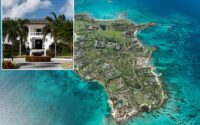I spent $1,750 to visit one of the most remote US national parks for a day: ‘Couldn’t help but cry’
Where we’re going, we don’t need roads.
One of the most remote US national parks is so far off the grid, the only way in is to fly, or hike for miles — and once you’re upclose with the 8.4 million-acre Gates of the Arctic National Park in Alaska, there are no marked trails or thoroughfares to guide you through the stunning terrain.
None of these obstacles managed to stop a Travel + Leisure reporter from making the trip recently — a costly caper that left her in tears, Emily Hart wrote.

The scenery-loving scribbler said the trip was the ultimate stop on a solo journey to visit all 63 national parks in the United States, which range from the most-visited Great Smoky Mountains in Tennessee and North Carolina to Alaska’s Gates of the Arctic, which attracted a paltry 11,045 visitors in 2023.
“This park is not a place travelers stumble upon; it’s a place they must seek out,” Hart explained — saying there’s nothing there to guide you “but your determination.”
After getting to Alaska — for most Americans, already a slog — the intrepid traveler boarded another flight from Anchorage to the coastal town of Kotzebue, 26 miles north of the Arctic Circle.
From there, she had to book yet another flight into the park, with a local outfitter. And forget sticking to a schedule, apparently — this far north, weather delays are apparently the norm, with some travelers forced to cool their heels for whole days waiting, and no guarantees the plane will ever take off.
But finally, after ponying up a whopping $1,750 for her record-setting day trip, her final flight managed to make the quick trip — dropping her off in “a world so untouched, it felt sacred,” the author wrote.
“The silence was almost overwhelming: just the faint sound of water beside me and the crunch of rocks under my hiking boots,” Hart said.
“I walked along the river. The water was so clear and blue that I could see every pebble on the riverbed, and I couldn’t help but cry. Thinking of the journey that brought me here — the 63rd national park I’d visited solo — I felt at peace.”
The park tends to be at its busiest in late summer, while fall (mid-September, this far north) means less competition for coveted space on bush planes, along with stunning fall colors, the expert said.

The tantalizing taste of tundra life comes as many of America’s national parks struggle with overcrowding — to the point where a growing number are forcing visitors to book their visits ahead of time.
This summer, travelers hoping for a glimpse of California’s Yosemite were expected to remember to snag a reservation in advance — or risk being denied entry to the park on arrival, The Post reported earlier.
A similar system has become the norm for Montana’s über-popular Glacier National Park, which had already been requiring drivers on the iconic Going-to-the-Sun Road to have a time-stamped access pass, which can be hard to snag during peak season.
Without the system, say rangers at parks like Mount Rainier, which is easily accessible from Seattle and Portland by car, visitors would end up waiting for hours to enter — jamming local roads and causing all sorts of other problems.


